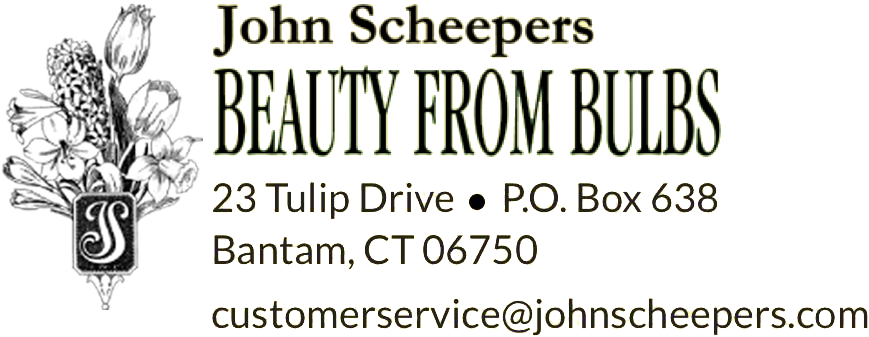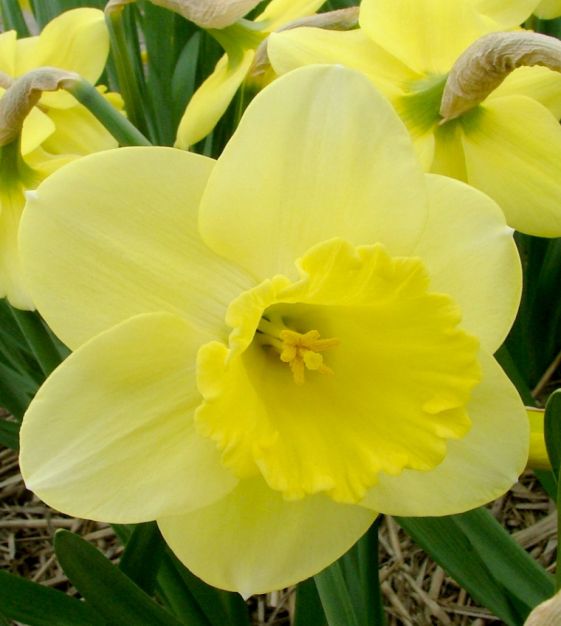-
- Website Specials
- New for 2025!
- Tulips
- Narcissi
- Allium
- Anemone blanda
- Brodiaea
- Camassia
- Chionodoxa
- Corydalis
- Crocus
- Eranthis
- Eremurus
- Erythronium
- Fritillaria
- Galanthus
- Geranium
- Gladiolus
- Hyacinths
- Hyacinthoides
- Ipheion uniflorum
- Dutch Iris
- Rock Garden Iris
- Ixiolirion
- Leucojum Aestivum
- Muscari
- Ornithogalum
- Oxalis
- Puschkinia
- Scilla
- Lilies
- Peonies
- Tender Bulbs
- Anemone Giants
- Tecolote Ranunculus
- Freesias
- Paperwhites
- Amaryllis
Narcissus Cairngorm
(2 YYW-WYY) A 1974 H. Richardson cross of Camelot and Daydream, it has a 4"-wide flower with sulfur-yellow petals with a white ringed base around a yellow corona that opens with a deeper, not quite orange glow and matures to sulfur-yellow. Narcissus Class: Large Cupped (Royal Horticultural Society Division 2). Bulb size: 14/16 cm. April. HZ: 3-7. Height: 18" to 20".
Narcissi are The Art & Soul of Spring.
Narcissus Horticultural Tips Narcissus Forcing Tips
Narcissi are The Art & Soul of Spring.
Narcissus Horticultural Tips Narcissus Forcing Tips
- Information
Large Cupped Narcissi
These bold, weather-tolerant Narcissi are known by their large cups that are trumpet-like, bowl-shaped or flat. The cups are more than one-third, but less than the length of their petals (perianth). Some have wavy, frilled, lobed or smooth cup edges and contrasting, colored rims. The shape and size of the petals determines the overall form of each flower: some are star-shaped, while others are round or look like double triangles. They offer a tremendous color diversity and promise repeat years of vital blooming. Large Cupped Narcissi bear one flower per stem. They are also much loved for the fact that deer and rodents do not like to eat them!
All Narcissi tolerate a wide range of sunlight from full sun to semi-shade. Varieties with pink cups are shades of light salmon, apricot-pink, coral or soft old rose. They should be grown in areas of filtered sunlight where their delicately colored cups may be protected from direct sunlight that bleaches out their pinkness. Narcissi prefer well-draining soil, hate to get wet feet and love to be fed with a 4-10-6 or 5-10-5 granular organic flower bulb fertilizer three times a year. Allow the foliage to thrive and die back naturally without braiding or premature removal. DNII bulb size: 14/16 cm, unless otherwise noted. Bloom time in a horticultural zone 5: April. Plant 6" to 8" deep and 6" apart. Horticultural zones 3-7. Height: 14" to 22", depending upon variety. Narcissus classification: Royal Horticultural Society Division 2.
Narcissi are The Art & Soul of Spring.
Narcissus Horticultural Tips Narcissus Forcing Tips
These bold, weather-tolerant Narcissi are known by their large cups that are trumpet-like, bowl-shaped or flat. The cups are more than one-third, but less than the length of their petals (perianth). Some have wavy, frilled, lobed or smooth cup edges and contrasting, colored rims. The shape and size of the petals determines the overall form of each flower: some are star-shaped, while others are round or look like double triangles. They offer a tremendous color diversity and promise repeat years of vital blooming. Large Cupped Narcissi bear one flower per stem. They are also much loved for the fact that deer and rodents do not like to eat them!
All Narcissi tolerate a wide range of sunlight from full sun to semi-shade. Varieties with pink cups are shades of light salmon, apricot-pink, coral or soft old rose. They should be grown in areas of filtered sunlight where their delicately colored cups may be protected from direct sunlight that bleaches out their pinkness. Narcissi prefer well-draining soil, hate to get wet feet and love to be fed with a 4-10-6 or 5-10-5 granular organic flower bulb fertilizer three times a year. Allow the foliage to thrive and die back naturally without braiding or premature removal. DNII bulb size: 14/16 cm, unless otherwise noted. Bloom time in a horticultural zone 5: April. Plant 6" to 8" deep and 6" apart. Horticultural zones 3-7. Height: 14" to 22", depending upon variety. Narcissus classification: Royal Horticultural Society Division 2.
Narcissi are The Art & Soul of Spring.
Narcissus Horticultural Tips Narcissus Forcing Tips
Large Cupped Narcissi
These bold, weather-tolerant Narcissi are known by their large cups that are trumpet-like, bowl-shaped or flat. The cups are more than one-third, but less than the length of their petals (perianth). Some have wavy, frilled, lobed or smooth cup edges and contrasting, colored rims. The shape and size of the petals determines the overall form of each flower: some are star-shaped, while others are round or look like double triangles. They offer a tremendous color diversity and promise repeat years of vital blooming. Large Cupped Narcissi bear one flower per stem. They are also much loved for the fact that deer and rodents do not like to eat them!
All Narcissi tolerate a wide range of sunlight from full sun to semi-shade. Varieties with pink cups are shades of light salmon, apricot-pink, coral or soft old rose. They should be grown in areas of filtered sunlight where their delicately colored cups may be protected from direct sunlight that bleaches out their pinkness. Narcissi prefer well-draining soil, hate to get wet feet and love to be fed with a 4-10-6 or 5-10-5 granular organic flower bulb fertilizer three times a year. Allow the foliage to thrive and die back naturally without braiding or premature removal. DNII bulb size: 14/16 cm, unless otherwise noted. Bloom time in a horticultural zone 5: April. Plant 6" to 8" deep and 6" apart. Horticultural zones 3-7. Height: 14" to 22", depending upon variety. Narcissus classification: Royal Horticultural Society Division 2.
Narcissi are The Art & Soul of Spring.
Narcissus Horticultural Tips Narcissus Forcing Tips
These bold, weather-tolerant Narcissi are known by their large cups that are trumpet-like, bowl-shaped or flat. The cups are more than one-third, but less than the length of their petals (perianth). Some have wavy, frilled, lobed or smooth cup edges and contrasting, colored rims. The shape and size of the petals determines the overall form of each flower: some are star-shaped, while others are round or look like double triangles. They offer a tremendous color diversity and promise repeat years of vital blooming. Large Cupped Narcissi bear one flower per stem. They are also much loved for the fact that deer and rodents do not like to eat them!
All Narcissi tolerate a wide range of sunlight from full sun to semi-shade. Varieties with pink cups are shades of light salmon, apricot-pink, coral or soft old rose. They should be grown in areas of filtered sunlight where their delicately colored cups may be protected from direct sunlight that bleaches out their pinkness. Narcissi prefer well-draining soil, hate to get wet feet and love to be fed with a 4-10-6 or 5-10-5 granular organic flower bulb fertilizer three times a year. Allow the foliage to thrive and die back naturally without braiding or premature removal. DNII bulb size: 14/16 cm, unless otherwise noted. Bloom time in a horticultural zone 5: April. Plant 6" to 8" deep and 6" apart. Horticultural zones 3-7. Height: 14" to 22", depending upon variety. Narcissus classification: Royal Horticultural Society Division 2.
Narcissi are The Art & Soul of Spring.
Narcissus Horticultural Tips Narcissus Forcing Tips





